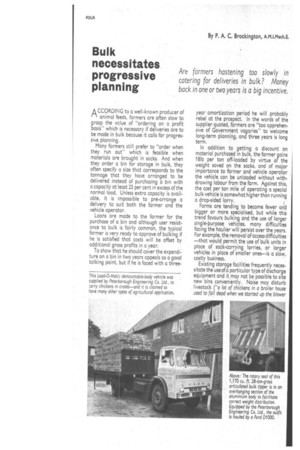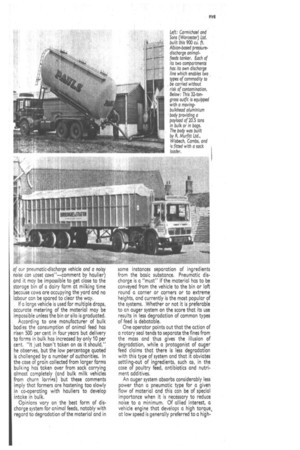Bulk necessitates progressive planning
Page 72

Page 73

Page 74

Page 77

If you've noticed an error in this article please click here to report it so we can fix it.
A CCORDING to a well-known producer of " animal feeds, farmers are often slow to grasp the vclue of "ordering on a profit basis" which is necessary if deliveries are to be made in bulk because it calls for progressive planning.
Many farmers still prefer to "order when they run out" which is feasible when materials are brought in sacks. And when they order a bin for storage in bulk, they often specify a size that corresponds to the tonnage that they have arranged to be delivered instead of purchasing a bin with a capacity at least 25 per cent in excess of the normal load. Unless extra capacity is available, it is impossible to pre-arrange a delivery to suit both the farmer and the vehicle operator.
Loans are made to the farmer for the purchase of a bin and although user resistance to bulk is fairly common, the typical farmer is very ready to approve of bulking if he is satisfied that costs will be offset by additional gross profits in a year.
To show that he should cover the expenditure on a bin in two years appeals as a good talking point, but if he is faced with a three year amortization period he will probably rebel at the prospect. In the words of the supplier quoted, farmers are "too apprehensive of Government vagaries" to welcome long-term planning, and three years is long term.
In addition to getting a discount on material purchased in bulk, the farmer gains 18Ib per ton off-loaded by virtue of the weight saved on the sacks, and of major importance to farmer and vehicle operator the vehicle can be unloaded without withdrawing labour from the farm. Against this, the cost per ton mile of operating a special bulk vehicle is somewhat higher than running a drop-sided lorry.
Farms are tending to become fewer and bigger or more specialised, but while this trend favours bulking and the use of larger single-Purpose vehicles, many difficulties facing the haulier will persist over the years. For example, the removal of access difficulties —that would permit the use of bulk units in place of sack-carrying lorries, or larger• vehicles in place of smaller ones—is a slow, costly business, Existing storage facilities frequently necessitate the use of a particular type of discharge equipment and it may not be possible to site new bins conveniently. Noise may disturb livestock ("a lot of chickens in a broiler house used to foil dead when we started up the blower of our pneumatic-discharge vehicle and a noisy noise can upset cows"—comment by haulier) and it may be impossible to get close to the storage bin of a dairy farm at milking time because cows are occupying the yard and no labour can be spared to clear the way.
If a large vehicle is used for multiple drops, accurate metering of the material may be impossible unless the bin or silo is graduated.
According to one manufacturer of bulk bodies the consumption of animal feed has risen 500 per cent in four years but delivery to farms in bulk has increased by only 10 per cent. "It just hasn't taken on as it should," he observes, but the low percentage quoted is challenged by a number of authorities, In the case of grain collected from larger farms bulking has taken over from sack carrying almost completely (and bulk milk vehicles from churn lorries) but these comments imply that farmers are hastening too slowly in co-operating with hauliers to develop intake in bulk.
Opinions vary on the best form of discharge system for animal feeds, notably with regard to degradation of the material and in some instances separation of ingredients from the basic substance. Pneumatic discharge is a "must" if the material has to be conveyed from the vehicle to the bin or loft round a corner or corners or to extreme heights, and currently is the most popular of the systems. Whether or not it is preferable to an auger system on the score that its use results in less degradation of common types of feed is debatable.
One operator points out that the action of a rotary seal tends to separate the fines from the mass and thus gives the illusion of degradation, while a protagonist of au9er feed claims that there is less degradation with this type of system and that it obviates settling-out of ingredients, such as, in the case of poultry feed, antibiotics and nutriment additives.
An auger system absorbs considerably less power than a pneumatic type for a given flow of material and this can be of special importance when it is necessary to reduce noise to a minimum. Of allied interest, a vehicle engine that develops a high torque, at low speed is generally preferred to a high
The rotary-seal discharge system of this Atkinsons of Clitheroe Ltd. three-compartment animal-feed bulk tipper enables cattle nuts to be discharged at rates up to 30 torts/hr. The tipper is based on a Bedford TK chassis/cab and is fitted with a light-alloy body. A transverse, o vertical and a boom auger are incorporated in the discharge system of the Bulkveyor tipping bodies produced by Byron Bulk Transporters Ltd., of Blackhorse Lane, London, E17, for the carriage of all types of agricultural material in bulk or bags. , The boom auger is reversible and can therefore be used for loading.
speed engine because of its lower noise level when it is being used to drive the power take-off.
The rotary-seal pneumatic discharge system has the advantage that it can be applied to conventional types of tipping vehicle without major modifications to the body structure, that the material can be tipped in the ordinary way and that the vehicle can conveniently be used to carry sacks. In the case of the pressure-discharge type of tanker, it can incorporate two or more compartments, each fitted with a discharge line and valve, so that two entirely different commodities can be carried without the possibility of one type of material contaminating the remainder.
While the tanker is suitable for carrying a wide variety of materials, it cannot be used for carrying sacks, which, it is claimed by the makers, is the only disadvantage of the system. The material is fluidized with the aid of a pneumatic pad and the system is stated to give degradation-proof delivery, provided that there are no sharp bends in the pipe connecting the discharge outlet to the silo.
In general, the need to provide a highly reliable discharge system and to obviate degradation has tended to reduce discharge rates, and one well-known bodybuilder cites 15 tons/hr. as the most acceptable rate for animal feeds, This bodybuilder also forecasts the increasing application of demountable bodies, notably when it is necessary to arrange loading and unloading to suit the convenience of the farmer and when the operation occupies a considerable time. Such bodies are currently employed for transporting crates of chickens.
Of the remaining systems in common use, the floor-conveyor type enables any material to be discharged up to 20ft or more with the aid of a slewing-boom bucket elevator and affords "gentle handling" of the material. There is virtually no limit to the range of materials that the system can handle, although the form and construction of the floor conveyor should match the properties of the load. Hydrostatic drive can be employed to vary the speed of the conveyors individually.
Obviously "if a bulk tipper will do" then it is the most suitable vehicle for deliveries in bulk, and although it is generally used for applications in which gravity discharge is acceptable a portable conveyor of the auger or belt type driven by an auxiliary engine can frequently be employed to provide a simple low-cost elevating system that caters for a more sophisticated storage system. A tipper equipped with fold-in sides increases its versatility in that it can be used as a platform vehicle as required. Partitions can be employed to provide multiple compartments for the carriage of a variety of loads or specified quantities of the same material. The moving-bulkhead type of bulk carrier has found favour with a number of operators in recent years in preference to a conventional tipper and can readily be equipped with a rotary-seal or auger-discharge system. It can also be divided into compartments and be employed for the carriage of bagged materials.
A problem that faces many bulk carriers of farm produce or materials is the wide variation in the weight of a given load, measured by volume, that results from differences in quality.
A poor quality product normally contains a relatively high proportion of fines and this may increase the weight of the load to such an extent that the gross weight of the vehicle or the load on one or more axles is exceeded by a wide margin.
While, therefore, the gross and axle weights of a bulk unit can be more accurately assessed or forecast than the loads carried by livestock hauliers, the effects of variations due to differences in quality can be a factor of major importance. Flexible liquid storage bags are used extensively in some overseas countries for the carriage of fertiliser and chemicals, notably in France and certain areas In Africa, and farmers in this country have shown an interest in their development and application.
Currently flexible bags, designed for transport to farms byroad vehicle, are available with capacities of 250ga1 up to 2,000gal having laden weights up to 10 tons which can readily be discharged into static flexible tanks on the farm. A bag can be mounted on a pallet for off-loading by a tractor fitted with a fork-lift attachment or may be transported on a trailer that can be left at the farm.












































































































































